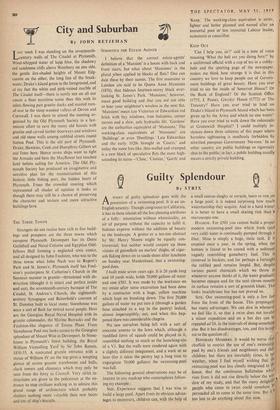THE THREE TOWNS
Strangers do not realise how rich in fine build- ings and prospects are the three 'towns which compose Plymouth. Devonport has its Doric Guildhall and Naval Column and Egyptian Odd- fellows Hall forming a neglected civic centre, and all designed by John Foulston, who was to the three towns what John Nash was to Regent's Park and St. James's; Plymouth itself has Foul- ston's masterpiece St. Catherine's Church in the Soanean manner in granite—threatened with de- struction (thought it is intact and perfect inside and out), the seventeenth-century baroque of The Citadel, St. Andrew's Church, the eighteenth- century Synagogue and Butterfield's convent of St. Dunstan built in local stone; Stonehouse was once a sort of Bath for retired naval people. Here are the Georgian Royal Naval Hospital with its granite colonnades, the Marine Barracks and the Foulston-like elegance of Emma Place. From Stonehouse Pool one looks across to the Georgian splendour of Mount Wise in Devonport. In Stone- house is Plymouth's finest building, the Royal William Victualling Yard- by Sir John Rennie, 1830-35. A rusticated granite entrance with a statue of William IV on the top gives a tempting glance of severe granite warehouses and halls, clock towers and chimneys which may only be seen from the ferry to Cremyll. Very strict, in- structions are given to the policeman at the en- trance to stop civilians walking in to admire this grand range of architecture which probably shelters nothing more valuable than new boots and tins of ship's biscuits.










































 Previous page
Previous page